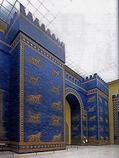Babylonian Empire
Ancient Babylonia - Nebuchadnezzar’s Babylon
The Ishtar Gate of Babylon in the Pargamon Meuseum in Berlin (original reconstruction)



Babylon
Babylon means "babilu" (gate of god). The ancient city was located in the plain of Shinar on the Euphrates River, about 50 miles south of modern Baghdad. Babylon was founded by Nimrod of Genensis 10, who developed the world's first organized system of idolatry, which Yahweh condemned Genesis 11. It later became the capital of Babylonia and the Babylonian empire. It was of overwhelming size and appearance.
In the Biblical year 4295 (539 B.C. Gregorian calendar) Cyrus led the Persian army to victory as prophesied over Babylon by diverting the Euphrates River during a Babylonian Feast. Nothing remains today of Babylon except a series of widely scattered mounds.
See Isaiah 13-14
Nebuchadnezzar's City
Nebuchadnezzar II (Nabu-kudurri-usur II) was the real genius and builder of Babylon. Of its 70 years in existence he ruled 45 years. As the commander of Nabopalassar's armies he was unstoppable. He broke the power of Egypt at the battle of Carchemish and proved to be one of the mightiest monarchs of all time. Among the cities he invaded and plundered were Tyre, Moab, Ammon, Edom, and Yahrusalem.
Inscriptions, documents and letters written during 43 years of his reign, give an idea of the power and wealth of Babylon. Here are some interesting facts according to the historian Herodotus. (Bk 1, 178-186) about Nebuchadnezzar's Babylon:
- Built in the form of a square, 14 miles on each side, and of enormous magnitude.
- The brick wall was approximately 56 miles long, 300 feet high, 25 feet thick with another wall 75 feet behind the first wall, and the wall extended 35 feet below the ground.
- 250 towers that were 450 feet high
- A wide and deep moat that encircled the city
- The Euphrates River also flowed through the middle of the city. Ferry boats and a 1/2 mi. long bridge with drawbridges closed at night.
-"Hanging Gardens"(one of the wonders of the ancient world) and water was raised from the river by hydraulic pumps
- Eight massive gates that led to the inner city and 100 brass gates
- Streets were paved with stone slabs 3 feet square
- The great Tower (Ziggurat) and 53 temples including the "GreatTemple of Marduk." 180 altars to Ishtar
- Golden image of Baal and the Golden Table (both weighing over 50,000 lbs of solid gold.)
- 2 golden lions, a solid gold human figure (18 feet high)
- Nebuchadnezzar’s palace was considered to be the most magnificent building ever erected on earth.




